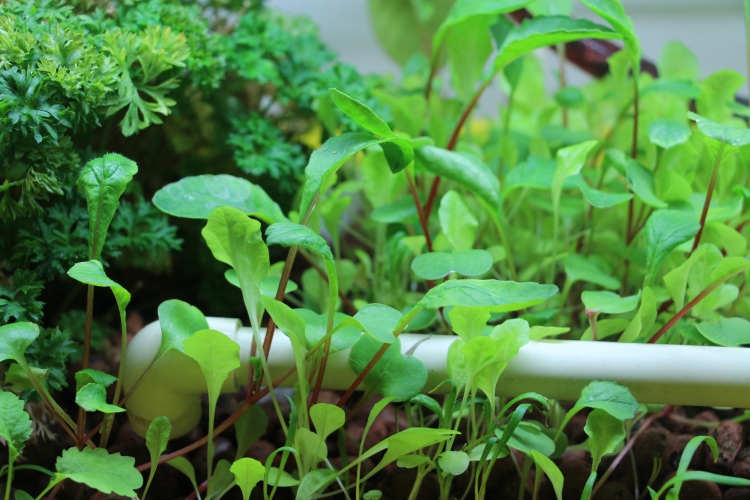During the summer, I attended Montréal’s Urban Agriculture School held at UQAM. During a week, I had the chance to participate in workshops, visit urban farms and meet fun and inspiring people.
On the last day of the week, we were presented with four different “house farms”. The teams had to come up with a concept to help urban people produce their own foods. Now, this is a great idea for so many reasons: making food accessible, encouraging people to eat more fresh vegetables and greens, having people think outside the box, and more. After listening to all four presentations, I have to say that I was sold to the idea. Among the four kitchen-farms, two of them were aquaponics systems (one named BioUnit, and the second, Yaku) and they were really inspiring.

So, when I came back home, I shared the idea with my boyfriend, and he was intrigued and hooked. We worked on it for a couple of months and made our very own kitchen-farm!

The most tedious part was to gather all the required material. We made a few trips to Ikea, home hardware stores and the Botanical Garden before we had the shelves, water pump, air pumps, tubing, clay beads and lights. Luckily, we already had an aquarium, so that reduced to costs a lot. We were also able to keep our parsley, strawberry, and thyme plants for our urban garden patch.
We also added some timers so that the lighting and watering would be automatic. The lights come on in the morning, and turn themselves off after 14 hours. As to the water, it circulates 10 minutes every 90 minutes. We have nothing to do! This is perfect for the lazy gardener (you do have to feed the fish however!).

The idea behind any aquaponics system is to have plants live on water-dissolved nutrients. However, unlike hydroponics systems where you have to keep adding nutrients to the water in liquid form that you buy, an aquaponics systems counts on fish poo to feed the plants.

The tricky part is to find a balance between what the plants’ needs and what the system can filter: as the water is “dirtied” by fish dejection, it is circulated through pumps to the plant baskets. The plants clean the water by absorbing the fish waste as their food. Finally, the water comes back into the aquarium by gravity. It is therefore important to make sure that the number of fish is not too high for what the plants can clean to avoid having them live in a toxic environment. To make sure that this was not the case, we bought a water testing kit. So far, our five fish have lived in a perfectly balanced environment and are quite lively.

For the last few months, we have had success with leafy greens and herbs. We are being adventurous now and trying out some tomato plants. We also have had some success with edamame beans, but our 3 plants produced 3 bean pods. Not the best outcome!
However, the best thing about this is that we can enjoy fresh greens and witness their growth from seeds, in the dead of winter (which also makes it difficult to harvest…). We are still working on this: we would like to grow our own fish food to avoid relying on store-bought fish food, but we are still figuring this out. We also like to experiment with different seeds and plants to see what works best.
Let us know if you have such a system at home and what you think of it! Also feel free to ask any questions, and I’ll try to answer them!
Thanks for liking my post on Dirt Nation, and stopping by. Your site is great!
Thanks! Yours too! 🙂